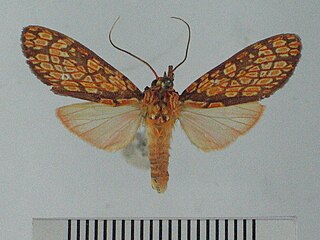
Cresera is a genus of moths in the family Erebidae. The genus was described by William Schaus in 1894.

Elysius is a genus of moths in the family Erebidae. The genus was erected by Francis Walker in 1855.

Eyralpenus is a genus of tiger moths in the family Erebidae. The genus was erected by Arthur Gardiner Butler in 1875. The moths in the genus are found in the Afrotropics.

Melese is a genus of moths in the family Erebidae. The genus was erected by Francis Walker in 1854.
Elysius intensa is a moth of the family Erebidae. It was described by Walter Rothschild in 1935. It is found in São Paulo, Brazil.
Eyralpenus scioana is a moth of the family Erebidae. It was described by Charles Oberthür in 1880. It is found in Angola, Cameroon, the Democratic Republic of the Congo, Ethiopia, Kenya, Malawi, Mozambique, Namibia, Tanzania, Uganda, Zambia and Zimbabwe.
Halysidota intensa is a moth of the family Erebidae. It was described by Walter Rothschild in 1909. It is found in Guatemala, Costa Rica, Honduras, Colombia, Venezuela, Ecuador, Peru and Bolivia.
Melese albogrisea is a moth of the family Erebidae. It was described by Walter Rothschild in 1909. It is found in Paraguay.
Melese columbiana is a moth of the family Erebidae. It was described by Walter Rothschild in 1909. It is found in Colombia.
Melese inconspicua is a moth of the family Erebidae. It was described by Walter Rothschild in 1909. It is found in Brazil.
Melese klagesi is a moth of the family Erebidae. It was described by Walter Rothschild in 1909. It is found in French Guiana, Suriname and Venezuela.
Melese nigromaculata is a moth of the family Erebidae. It was described by Walter Rothschild in 1909. It is found in French Guiana, Suriname, Brazil, Venezuela and Peru.
Melese peruviana is a moth of the family Erebidae. It was described by Walter Rothschild in 1909. It is found in Peru.
Melese punctata is a moth of the family Erebidae. It was described by Walter Rothschild in 1909. It is found in Ecuador.
Melese pusilla is a moth of the family Erebidae. It was described by Walter Rothschild in 1909. It is found in French Guiana, Suriname, Guyana and Brazil.
Melese quadripunctata is a moth of the family Erebidae. It was described by Walter Rothschild in 1909. It is found in Peru.
Melese rubricata is a moth of the family Erebidae. It was described by Paul Dognin in 1910. It is found in French Guiana.
Melese underwoodi is a moth of the family Erebidae. It was described by Walter Rothschild in 1917. It is found in Costa Rica.
Pryteria alboatra is a moth in the family Erebidae. It was described by Walter Rothschild in 1909. It is found in Costa Rica, French Guiana, Venezuela, Peru, Brazil and Bolivia.
Secusio drucei is a moth in the subfamily Arctiinae. It was described by Walter Rothschild in 1933. It is found in Angola, Kenya and Uganda.



